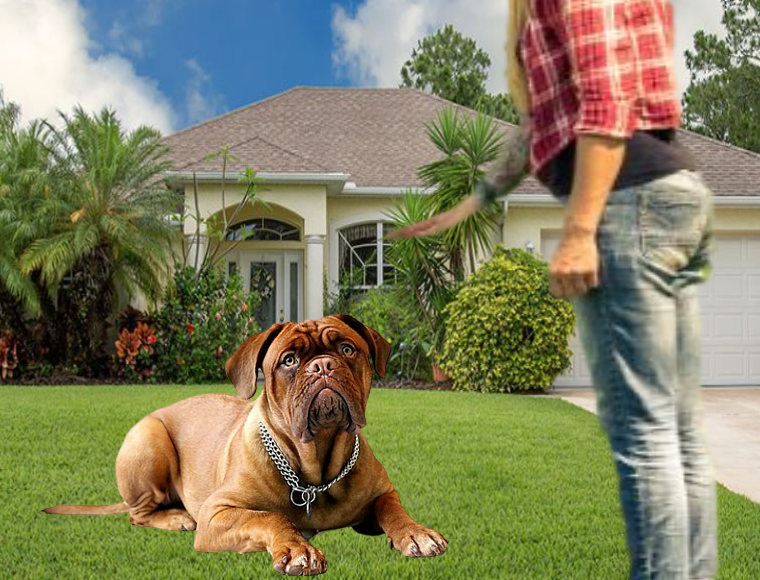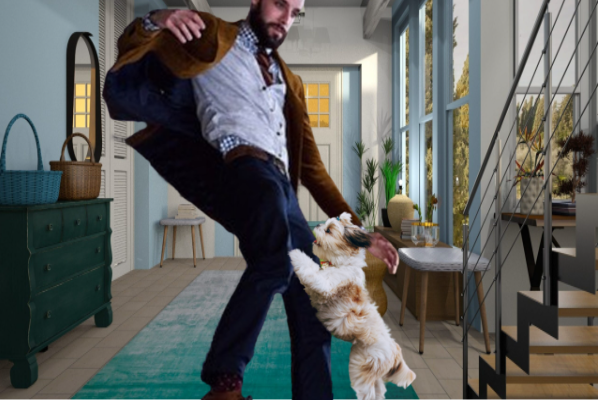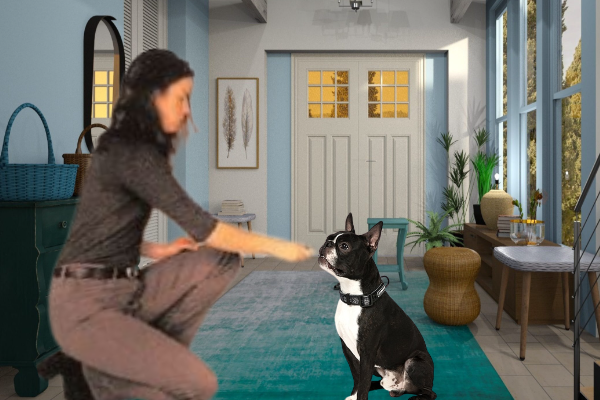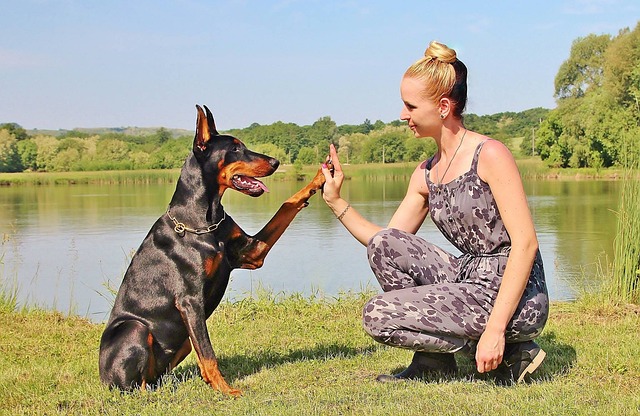How to train dogs not to jump post may contain affiliate links. Learn more on my Affiliate Disclosure page.
How to train dogs not to jump can be a challenge. Do you often find yourself dodging an enthusiastic canine leaping up to greet you? As adorable as it may seem, jumping can quickly become a nuisance in dogs.
Whether out of excitement or a desire for attention, this habit can overwhelm both owners and visitors. But fear not!
This article will explore practical techniques to train your furry friend not to jump. By implementing these strategies, you’ll be well on your way to enjoying calm and composed greetings with your beloved pooch.
How To Train Dogs
Not To Jump On People
Jumping is a common issue with dogs, and it often stems from a combination of excitement and poor training.
Many owners unknowingly encourage this behavior by reinforcing it unintentionally. When a dog jumps up to greet their owner, they are usually met with laughter or touching, inadvertently rewarding the behavior.
A reward creates confusion for the dog, as they perceive jumping as a positive action. Therefore, proper training is crucial to address this issue.
You can learn how to train dogs not to jump by addressing the underlying motivation behind jumping, which is essential in preventing this behavior from becoming ingrained in your furry friend’s actions.
Dogs often jump to gain attention or establish dominance. You can redirect their energy into more suitable behaviors by providing them with alternative ways to get attention and teaching them basic commands like sit or stay.

If you’re wondering how to train your furry friend not to jump, here’s a tip: redirect their energy! Instead of jumping for attention or asserting dominance, teach them alternative ways to seek attention and basic commands like sit or stay. It’s a win-win situation – they’ll learn better behavior while still getting the attention they crave!
Reinforcing calmness during greetings and discouraging jumping through consistent correction will help your dog understand not to jump.
Additionally, setting clear boundaries through positive reinforcement plays a significant role in curbing unwanted jumping habits in dogs. Establishing consistency within the household lets your pup understand that jumping up will not yield any rewards or attention from anyone present.
You can discover how to train dogs not to jump by recognizing body language, and verbal cues will teach your dog not to jump. But when you give off conflicting signals, your dog may get confused and hinder progress.
By addressing the root causes behind why dogs jump and implementing effective strategies for training, you can successfully guide your four-legged companion towards more appropriate behaviors while strengthening the bond between you both.
How To Train Dogs Not To Jump By Understanding The Root Cause
How to train dogs not to jump is by understanding the root cause of jumping is crucial when training dogs not to exhibit this behavior.
Jumping is often a result of excitement or attention-seeking, as dogs use their bodies to communicate their enthusiasm. However, it can also stem from fear or anxiety.
By recognizing the underlying reasons behind this behavior, we can approach training with empathy and address the root cause effectively.
For some dogs, jumping becomes a way to gain attention and affection from their owners or other people around them. We reinforce this behavior by inadvertently rewarding it when they jump on us.

When it comes to training dogs not to jump, it’s important to understand that some pups use this behavior as a means of seeking attention and love from their owners or those nearby. The unintentional reinforcement occurs when we unknowingly reward them for jumping on us.
Understanding that dogs seek validation and interaction can help us break this cycle by rewarding them only when all four paws are on the ground.
On the other hand, jumping may also express fear or anxiety in certain situations.
In these cases, it becomes crucial to identify triggers that make your dog uncomfortable and work on desensitizing them over time.

By using positive reinforcement techniques and exposing our furry friends to alternate behavior situations, we can teach them not to jump on people.
Providing positive reinforcement and practicing gentle exposure can help our furry companions feel more secure and less likely to jump for comfort.
How To Train Dogs Not To Jump Establish Boundaries And Rules
How to train dogs not to jump by establishing clear boundaries and rules is crucial when training your dog not to jump.
Dogs, like humans, thrive on structure and consistency. They can become confused and frustrated without clear guidelines, leading to undesirable behaviors such as jumping.
By establishing boundaries early on in their training process, you can effectively communicate what is acceptable behavior while minimizing the chances of them jumping up on people.
When setting these boundaries, you must be consistent with your expectations and enforce them across all environments.
Dogs are quick learners but can quickly get confused if the rules change depending on the situation.
For example, it confuses your pet if you don’t allow your dog to jump on guests at home but let them do so at the park. Consistency is vital in teaching dogs what we want from them and what they need to avoid doing.
In addition to consistency, positive reinforcement plays a vital role in establishing clear boundaries and rules. Dogs respond well to praise and rewards when they exhibit desired behaviors.
When teaching your dog not to jump, rewarding them for keeping all four paws on the ground will reinforce that this behavior is more desirable than jumping up.

By highlighting good behavior instead of focusing solely on correcting bad habits, we create an environment in which dogs feel motivated and eager to follow our lead.
How To Train Dogs Not To Jump By Using Alternative Behaviors
Jumping is a common issue that many dog owners face. While it may seem innocent and even adorable to have a furry friend jump up on you, it can become problematic, especially when guests come over or in public settings.
An effective technique is teaching your dog to offer their paw instead of jumping. This simple action gives them an outlet for their excitement and allows them to engage with people without being physically overwhelming.
By consistently rewarding this behavior and discouraging jumping, you can gradually replace the unwanted behavior with a new skill you and your pup will appreciate.
Consistency and Reinforcement
How to train dogs not to jump by being consistent and reinforcing the crucial aspects of training dogs not to jump.
Dogs thrive on routine, so establishing a consistent approach is critical. If you set clear boundaries and consistently enforce them from the beginning, your dog will quickly learn what behaviors are acceptable.
For instance, if you don’t want your dog jumping on you or others, always ignore their jumping behavior and refuse to give them attention until they calm down.
Positive Reinforcement is equally essential in training. Dogs respond well to getting treats or praise when they exhibit desired behaviors. When teaching your dog not to jump, ensure that you reward them every time they remain calm with all fours on the ground when greeting someone.
This positive association with good behavior will encourage them to repeat it in the future.
Consistency and Reinforcement go hand in hand in practical dog training. Your dog will gradually understand that jumping is unacceptable by being consistent with your expectations and enforcing boundaries while providing positive reinforcements for good behavior.
Manage Jumping Behavior Triggers
Managing situations that trigger jumping behavior can be challenging for dog owners. One effective way to tackle this issue is by identifying the specific triggers that set off your dog’s enthusiasm to jump.
It could be something as simple as the doorbell ringing or visitors entering the house.
Once you have identified these triggers, you can take proactive steps to manage them. For example, when guests arrive, your dog gets overly excited. You need to address their excitement before they even reach the door.
Engage your canine companion in calming exercises such as sitting or lying down, and reward them for staying calm during greetings.
Another critical aspect of managing jumping behavior is consistent reinforcement of desired behaviors.
Dogs thrive on routine and clear guidelines from their owners, so it’s crucial to establish and communicate what is expected from them concerning greeting behavior.
For instance, teach your dog an alternative behavior, like sitting instead of jumping up on people.
Practice this consistently with each arrival or encounter until it becomes second nature for you and your furry friend.
Remember, managing trigger situations requires patience and persistence from you as a pet owner.
Stay calm while guiding your dog through these circumstances, using positive reinforcement techniques such as rewards and praise whenever they exhibit appropriate behaviors.
Over time, with consistency and understanding, you can effectively manage situations that trigger jumping behavior in your canine companion.
Provide Mental and Physical Stimulation
One may think that dogs jumping out of excitement or seeking attention is an endearing behavior, but it can quickly become a nuisance if not correctly addressed.
While some may reprimand or scold their furry friends for this habit, it’s important to remember that dogs are highly social creatures with a natural desire for interaction and play.
Instead of punishing them for expressing joy, consider channeling their exuberance into more appropriate behaviors through sufficient mental and physical stimulation.
Training your dog not to jump begins with understanding the underlying reasons behind this behavior.
Dogs often jump as a way to release pent-up energy or because they crave attention from their human companions. By providing them with plenty of exercise and mental engagement, such as interactive toys or puzzle games, you can help redirect their enthusiasm in constructive ways.
Regular walks, trips to the dog park, and engaging training sessions will tire them physically and stimulate their minds, resulting in calmer behavior overall.
In addition to physical activities, it’s essential to teach your dog alternative methods of seeking less intrusive attention than jumping up on people. Encourage behaviors like sitting down or offering a paw when they want your focus instead of leaping onto you.
Rewarding these desired actions will reinforce the idea that polite gestures get them what they wish, while jumping does not.
Remember, consistency and positive reinforcement go hand in hand when training your pup—consistently rewarding good behavior will yield more effective results than sporadic attempts at correction.
Dog Exercise Equipment
As pet owners, we all know that exercise is essential for our furry friends to maintain a healthy lifestyle. But sometimes, a regular walk around the block isn’t enough to tire out an energetic pup.
That’s where dog exercise equipment comes in handy. Not only does it provide physical activity, but it also mentally stimulates our dogs and helps prevent behavior problems such as jumping.
One popular piece of dog exercise equipment is the agility course. These courses typically consist of jumps, tunnels, weave poles, and other obstacles requiring your dog to navigate them quickly and efficiently.
The great thing about agility training is that you can start at any level based on your dog’s abilities and gradually increase the difficulty as it improves.
Another effective tool for tiring out dogs is a flirt pole – a long pole with a rope or toy attached to the end that you can wave around enticingly for your pup to chase.
A flirt pole mimics natural prey movements and engages their instincts while providing an excellent cardiovascular workout.
Remember to give your dog breaks between play sessions when using a flirt pole so they don’t overexert themselves.
Integrating these fun and engaging exercises into your dog’s routine tires them out not only physically but also mentally stimulates their senses, preventing them from getting bored and potentially engaging in undesirable behaviors like incessant jumping.
The ASOCEA Dog Flirt Stick Pole is the ultimate interactive toy that will keep your dog entertained for hours! Its extendable pole and enticing fluffy tail make it perfect for chasing and pouncing, satisfying your pup’s natural instincts.
The XiaZ Dog Agility Equipment will create an alternate behavior that promotes controlled jumping. And it is a great way to strengthen the bond between you two. Spend quality time together while teaching your pup new skills and watching them enthusiastically conquer each challenge.
So get creative with different dog exercise equipment options available today – you’ll be amazed at how much you and your furry friend will enjoy this type of training!
Conclusion: How To Train Dogs Not To Jump
In conclusion, how to train dogs not to jump on you or guests can be demanding. But getting a well-behaved, non-jumping dog requires consistency, patience, and understanding.
When you know the root cause of jumping behavior, provide appropriate alternative behaviors for your furry friend. You can effectively discourage jumping by implementing positive reinforcement techniques.
Additionally, it is essential to acknowledge that training a dog not to jump is an ongoing process that requires commitment from both the owner and the dog.
Consistent reinforcement of desired behavior in various social situations will help solidify the training.
Remember, dogs jump out of excitement or to seek attention; therefore, it is crucial to provide them with sufficient mental and physical stimulation throughout the day.
Mental could include regular walks or playtime activities that channel their energy positively.
Following these guidelines and working consistently with your dog on their jumping behavior can transform your four-legged companion into a polite, well-mannered household member.Learn more at the American Kennel Club about this topic.
K9 Training Institute Free Workshop
The K9 Training Institute offers a free workshop where you can learn firsthand their effective training methods.
The Free Workshop emphasizes building a solid bond between you and your pup. They explain how to apply positive reinforcement techniques that make learning enjoyable for dogs and their owners.
Does your dog tug on its leash, bark constantly, and won’t come when called? Sign Up and get the FREE Obedience Training Workshop Now!




